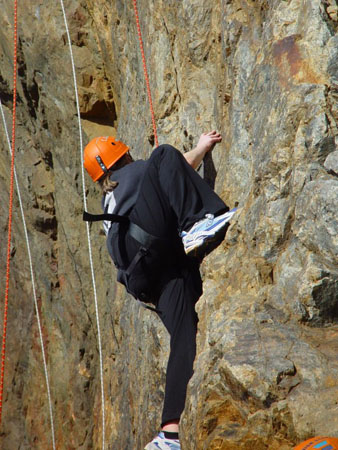Although it is possible under some circumstances to photograph rock climbers from the safety of the ground, in most cases the best images are obtained by other climbers suspended on ropes beside the action. It is therefore important to be an accomplished rock-climber as well as a photographer. Images taken from ropes, and in other situations that obviously imply involvement, inevitably have more impact than those obtained from the safety of the ground.
 |
| By Leon Brooks [Public domain], via Wikimedia Commons |
Rocks are not, in themselves, visually interesting to most photographers. It is the activity of the rock-climber and the portrayal of the challenge which makes an image compelling. The photographer's objective is therefore to show the extraordinary situation in which the climber is working, and give the viewer some feeling for the height, danger and physical strength involved.
Photographic equipment is easily damaged and should be carried on a lanyard to prevent it from being dropped, and housed in a waterproof and suitably padded bag to provide basic protection against water and impacts of various types. It is also worth attaching accessories such as lens caps using a small piece of cord. The equipment itself is a matter of personal choice, but the ideal camera for a rock-climber is light, resilient, waterproof, equipped with autofocus, tolerant of low temperatures, and easy to use with gloved hands. Most good quality 35mm SLRs, or their digital equivalent, are useable but some are more rugged and easier to use than others. Nikons perform well at low temperature when equipped with lithium batteries. Use a camera that accepts AA batteries as these are readily available worldwide. Fit all the lenses with UV filters to protect the front elements and reduce the level of UV recorded in the images.
Climbing in a group of three people allows a photographer to have his or her hands free to use a camera. When only two people are involved this is not so easy to achieve. A photographer can also sometimes get interesting angles on climbers by taking an easy route to the top of the climb and, if necessary, abseiling down to the level of the ascending rock-climbers. Traverses also offer good viewpoints as the ground above and below the climbers may be incorporated in to compositions. Both telephoto and wide-angle lenses are useful. A telephoto lens can be used to focus on the activity of a single climber in a spectacular location, whilst a wide-angle lens is useful to show the broader situation and perhaps several members of the climbing group.






